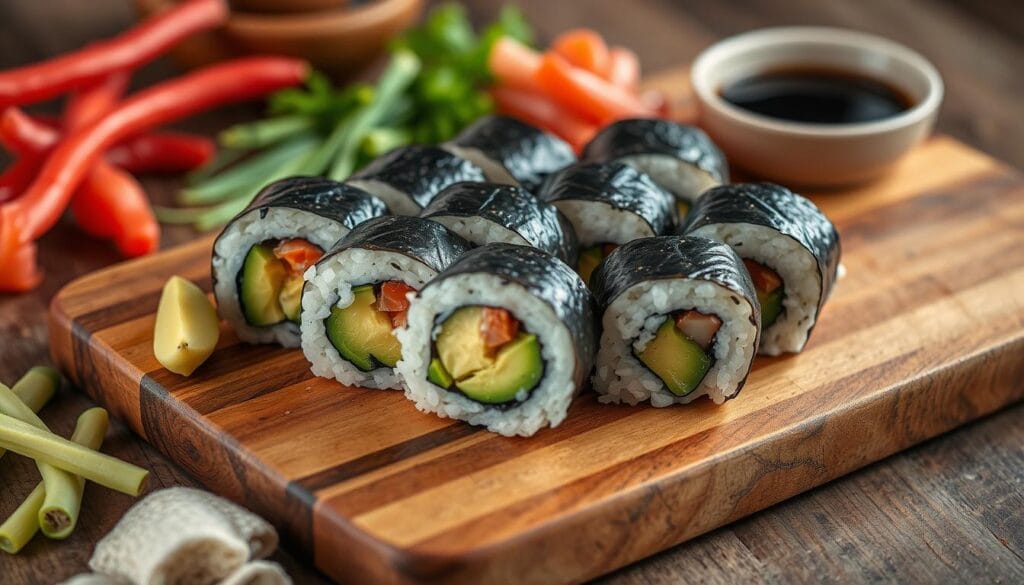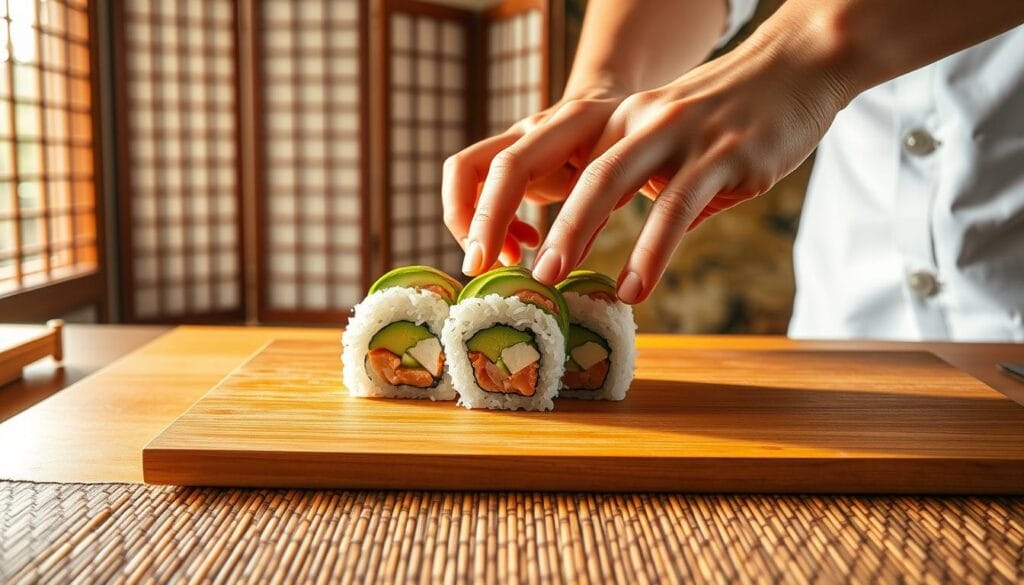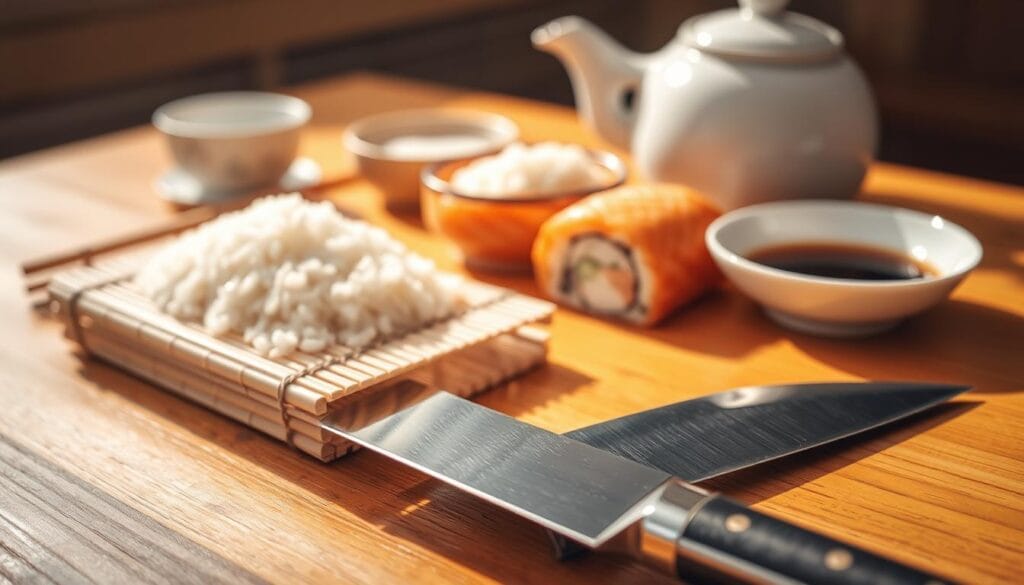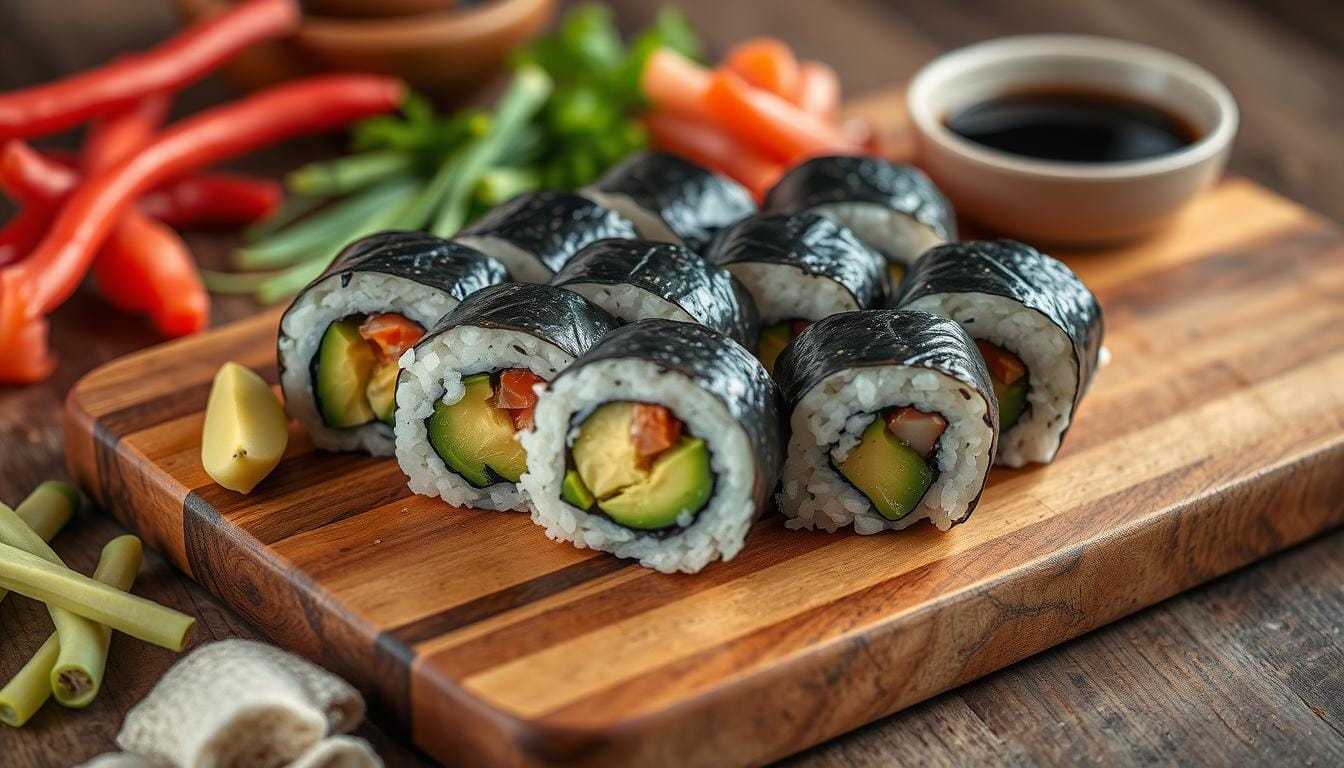Easy Sushi Roll Recipe to Make at Home
Welcome to our guide on making delicious sushi rolls at home. We focus on easy recipes and seafood options perfect for any occasion. You’ll find a variety of seafood recipes to make your own unique sushi roll.
Making sushi rolls at home is fun and rewarding. You can try different fillings like spicy tuna, crab, and avocado. This lets you create a sushi roll that matches your taste.

We aim to give you the tools and knowledge for easy recipes at home. This includes many seafood recipes for your sushi rolls. Whether you’re new or experienced, our guide will help you make tasty sushi rolls at home.
Introduction to Sushi Making
Making sushi rolls at home is simpler than you might think. With our guide, you can create your own recipes using various seafood options. We’ll teach you the basics of sushi rice and how to roll the perfect sushi.
Key Takeaways
- Learn how to make easy recipes at home using seafood recipes
- Discover the basics of making sushi rice and rolling the perfect sushi roll
- Explore a variety of seafood recipes that can be used in your sushi roll recipe
- Get tips and tricks for making your sushi rolls stand out
- Learn how to create your own unique sushi roll recipe using easy recipes and seafood recipes
The Art and History of Sushi Rolling
Sushi has a rich sushi history that goes back to ancient Japan. The art of sushi rolling has grown over time. Today, we see many different sushi rolls.
To grasp the art and history of sushi rolling, we must look at its traditional Japanese roots. Traditional sushi is a big part of Japanese food. Its growth is linked to Japan’s culture and traditions.

- Using fresh, high-quality ingredients
- Mastering the technique of sushi rolling
- Understanding the importance of presentation and plating
By diving into the art and history of sushi rolling, you can make real and tasty sushi rolls. These rolls will show off traditional sushi techniques and ingredients. Whether you’re an experienced sushi chef or just starting, exploring sushi history and rolling is both rewarding and delicious.
| Type of Sushi | Description |
|---|---|
| Maki | Rolling sushi with rice and fillings |
| Nigiri | Hand-formed sushi with rice and toppings |
| Sashimi | Raw fish sliced into thin pieces |
Essential Tools and Equipment for Sushi Making
To make delicious sushi rolls, you need the right sushi tools and sushi equipment. These kitchen essentials are key to perfect sushi rolls. Start with a quality sushi mat, a sharp knife, and a rice cooker.
Here are some essential tools and equipment to get you started:
- Sushi mat: for rolling and shaping sushi
- Sharp knife: for cutting and preparing ingredients
- Rice cooker: for cooking Japanese rice to the right consistency
When picking your sushi equipment, look at the material, durability, and ease of use. Good quality sushi tools last long and make sushi-making easier. With the right kitchen essentials, you’ll make delicious sushi rolls at home.

Selecting the Perfect Seafood Recipes for Your Rolls
Choosing the right seafood for sushi rolls is crucial for taste and quality. With many seafood recipes available, picking the best can be tough. Let’s explore key factors like fish guidelines and seafood combinations to help you decide.
Freshness is key when picking seafood. Fresh fish often tastes better and feels nicer in your mouth. But, frozen fish can also be great if it’s handled and stored right. Some tasty seafood combinations include salmon with avocado and cucumber, or shrimp with crab and mayo.
Here are some tips for picking the perfect seafood for your sushi rolls:
- Choose fresh, sustainable seafood whenever possible
- Follow proper fish guidelines for handling and storage
- Experiment with different seafood combinations to find your favorite
By following these tips and carefully considering your options, you can make delicious sushi rolls. These rolls will highlight your favorite seafood recipes.
Mastering Sushi Rice Preparation
To make delicious sushi, you must master sushi rice preparation. Japanese rice is key in any sushi roll. The right rice type, water ratio, and cooking method are crucial.
Here are some tips for preparing sushi rice:
- Use short-grain Japanese rice, which is specifically designed for sushi.
- Rinse the rice thoroughly before cooking to remove excess starch.
- Use the correct water ratio, which is typically 1:1 for Japanese rice.
Seasoning the sushi rice is also important. You can use rice vinegar, sugar, and salt. The goal is to enhance the sushi’s taste without overpowering it.
By following these tips and practicing rice preparation, you can make delicious sushi at home. With the right ingredients and techniques, you can create many sushi rolls. You can use different types of Japanese rice and fillings.
Proper Nori Selection and Handling
Nori sheets are key to making tasty sushi. The right nori selection can greatly affect your sushi’s taste and feel. Nori sheets, or seaweed sheets, are dried and pressed seaweed. They come in different types and qualities.
To pick the best nori sheets for your sushi, think about these things:
- Texture: Find nori sheets that are smooth and even.
- Flavor: Go for nori sheets with a mild, slightly sweet taste.
- Nutritional content: Choose nori sheets that are full of vitamins and minerals.
It’s also important to store and handle nori sheets right. Keep them in a cool, dry spot, away from sunlight and moisture. When you’re getting ready to use them, handle them carefully to avoid damage.
By picking and handling nori sheets correctly, you can make sushi rolls that everyone will love. Always choose high-quality nori sheets and store them well for the best taste and texture.
Step-by-Step Rolling Technique
To master sushi rolling, you need to know the basics. With patience and practice, you can make sushi rolls that wow everyone. The secret is using the right amount of filling, applying even pressure, and slicing correctly.
Start with the basic roll formation. Place a nori sheet flat on your sushi mat, with the shiny side down. Spread a thin layer of sushi rice on the nori, leaving a small border at the top. Then, add your fillings, like salmon or cucumber, in the middle of the rice.
Basic Roll Formation Tips
- Use short-grain Japanese rice, which is specifically designed for sushi rolling
- Handle the nori sheets gently to avoid cracking or breaking
- Apply even pressure to form a compact roll
For advanced rolls, try the inside-out roll method. Place fillings on the outside of the roll. This method takes practice but is worth it. With these tips, you’ll soon be making beautiful sushi rolls.
Follow these steps and practice your technique. You’ll become a sushi rolling master. You’ll be able to make many delicious rolls with different fillings and techniques.
Essential Sushi Condiments and Garnishes
To make your sushi better, knowing about condiments and garnishes is key. These add taste, texture, and look to your sushi. Japanese condiments like soy sauce, wasabi, and pickled ginger are must-haves.
Remember, a little of these condiments is enough. Here are some important ones:
- Soy sauce: makes the sushi taste better
- Wasabi: gives a spicy flavor
- Pickled ginger: adds a sweet and sour taste
Sushi garnishes also matter a lot. Sushi garnishes like sesame seeds, grated daikon, and shiso leaves brighten up your sushi. Using these, you can make your sushi look and taste amazing.
Learning about sushi condiments and garnishes lets you try new things. Whether you love sushi or are new to it, these items will help you make great sushi. Your sushi will look and taste fantastic.
Creative Filling Combinations
Sushi fillings are its heart. With many options, choosing the right mix can be tough. Creative fillings can make your sushi unique. Start with classics like salmon, tuna, and crab, found in many sushi places.
But, you can also try new things. Sushi fillings can include spicy tuna, crab mix, and avocado. These creative fillings give classic rolls a fresh twist. For veggie lovers, cucumber, carrot, and asparagus make tasty, healthy rolls.
Pair these ingredients with creative fillings like spicy mayo, sriracha, and sesame seeds. This way, you can make rolls that are all your own. Enjoy the fun of making your own sushi.
Plating and Presentation Tips
Serving sushi is not just about the taste. The way it looks matters a lot. Japanese plating is all about keeping things simple, balanced, and harmonious. To make sushi rolls look great, think about the colors, textures, and how you arrange the ingredients. A dish that looks good can make the sushi taste even better.
To make your sushi look stunning, pick the right plate. Choose one that matches the sushi’s colors and textures. Also, think about the plate’s size and shape compared to the sushi. Adding garnishes like sesame seeds, grated daikon, or scallions can add color and texture.
For a modern twist, try using unique ingredients or sauces. You can also play with the sushi’s shape and arrangement. This can make your dish stand out. Some cool Japanese plating styles include:
- Using a centerpiece, like a small bowl of sauce or a garnish, to add interest
- Creating a balanced mix of colors and textures
- Adding a splash of color, like a citrus slice or sesame seeds
By using these presentation tips and trying out different sushi plating styles, you can make sushi that looks amazing. This will impress your guests and make the meal even more enjoyable.
Conclusion: Your Journey to Becoming a Home Sushi Chef
Congratulations on your journey to becoming a skilled home sushi chef! You now have the knowledge and techniques to make delicious Japanese dishes at home. Remember, the key to mastering sushi is practice, fresh ingredients, and a love for new flavors.
As you keep making sushi, try new seafood, fillings, and ways to present it. Let your creativity in sushi rolling shine. Each roll you make will impress your loved ones and deepen your love for sushi’s rich culture.
So, keep your sushi mat ready, your knife sharp, and your mind open to new possibilities. Start this culinary journey with excitement. Let your homemade sushi rolls take you to the heart of Japanese culinary excellence.
FAQ
What is the history of sushi rolling?
Sushi has a long history in Japan. It started with simple rice and fish. Now, we have many types of sushi rolls. Knowing its history helps make authentic and tasty sushi.
What are the essential tools and equipment needed for sushi making?
Making sushi rolls needs the right tools. You’ll need sushi mats, sharp knives, and rice cookers. Using the right tools and learning how to use them is key to making great sushi.
How do I select the perfect seafood recipes for my sushi rolls?
Choosing the right seafood is important for taste and quality. You should know about fresh and frozen fish. Also, learn about safe handling and storage to get the best seafood.
How do I master the art of sushi rice preparation?
Sushi rice is essential for sushi. You need to know how to prepare it right. This includes the right rice, water ratio, and cooking method. Also, learn how to season and prepare it for your rolls.
How do I properly select and handle nori sheets?
Nori sheets are key for sushi rolls. You need to know how to choose and handle them. This includes understanding different types of nori, their texture, flavor, and nutritional value. Also, learn how to store and prepare them.
What is the step-by-step rolling technique for sushi?
Rolling sushi takes patience and practice. You need to know the basic roll formation and the inside-out method. It’s also important to use the right amount of filling and slice the rolls correctly.
What are the essential sushi condiments and garnishes?
Sushi condiments and garnishes add flavor and look. You’ll need soy sauce, wasabi, and pickled ginger. Learn how to use them to enhance your sushi’s taste and look.
What are some creative filling combinations for sushi rolls?
Creative fillings make sushi special. You can use classic Japanese fillings or try modern fusion options. Vegetarian alternatives are also great. Learn how to mix flavors, textures, and colors for unique sushi.
How do I plate and present my sushi rolls?
How you present your sushi rolls matters. You can use traditional or modern plating. Garnishes, sauces, and other elements can make your sushi look great.https://www.recipeskic.com/

